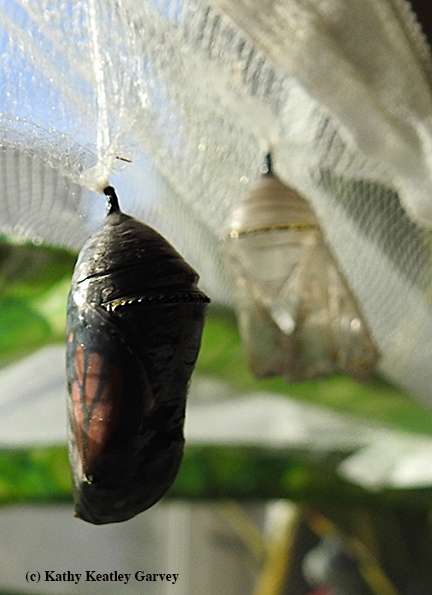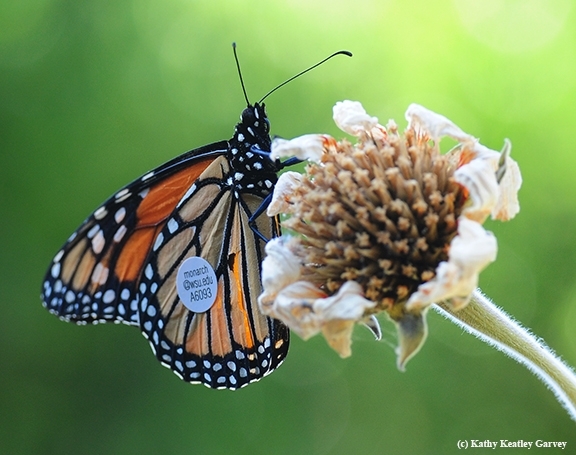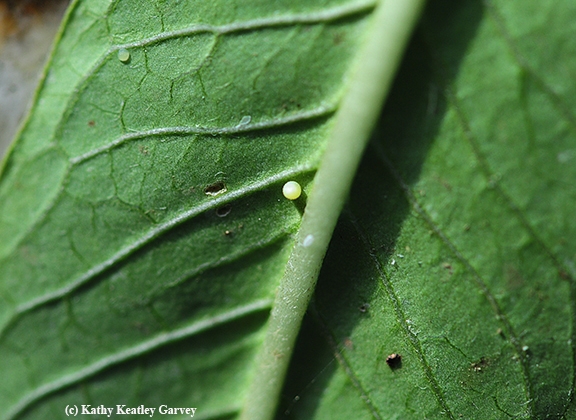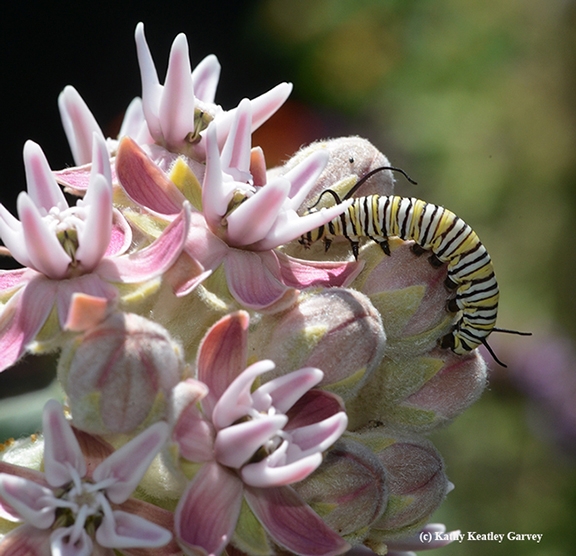
Looking back at 2016, monarch butterflies reigned supreme--or at least they did in this Bug Squad blog!
Finding--and photographing--a tagged monarch butterfly (monarch@wsu.edu A6083) in our pollinator garden in Vacaville, Calif. on Labor Day, Sept. 5, highlighted the year. The migratory butterfly, a male, was part of a research project led by Washington State University entomologist David James, who maintains a network of Pacific Northwest citizen scientists who rear, tag and release monarchs (Danaus plexippus).
Turns out that Steve Johnson of Ashland, Ore., a member of the Southern Oregon Monarchs Advocates (SOMA), reared A6083. Johnson tagged and released the monarch in Ashland on Aug. 28, which means "that it flew 285 miles in 7 days or about 40.7 miles per day" to reach Vacaville on Sept. 5, James related.
Amazing! Amazing and serendipitous for several reasons: (1) I'd written a piece about James' research in October 2014, alerting readers to watch for tagged monarchs (and never expecting to see or photograph a WSU-tagged butterfly in our own backyard) (2) WSU is my alma mater, and (3) our family rears monarchs as a small-scale conservation project to help the declining monarch population.
Our pollinator garden caters to bees and butterflies. For the monarchs, we provide four species of milkweed, ranging from narrow-leaf to broadleaf, and grow such nectar-producing plants as Mexican sunflower (Tithonia) to butterfly bush (Buddleia), and Lantana.
This year our monarch-rearing season proved quite lengthy; it crept into winter. Monarchs continued to lay their eggs throughout November, with chrysalids forming in December. Today the reared-and-released tally is 62 and counting...counting because No. 63 eclosed Dec. 29 and has not yet been released, and No. 64 is still a chrysalis.
"Monarch Moms" and "Monarch Dads" and "Monarch Kids" differ in their rearing activities, but the concept is the same: protect them from predators and parasites. Otherwise about 97 percent of the eggs never complete the cycle of egg, caterpillar, and chrysalis to adult. We rear our caterpillars indoors in a zippered, meshed butterfly habitat (purchased from the Bohart Museum of Entomology, UC Davis), but some laundry bags will suffice. We fill a heavy, flat-bottomed, narrow-necked tequila bottle with water and just add milkweed and 'cats. There they munch on milkweed, pupate, and eclose. The best part of rearing monarchs? Releasing them. The lift-off, the flutter of wings, and it's time to be a butterfly.
A look back at the WSU traveler and a view of the monarch life cycle that unfolded in our pollinator garden:
Attached Images:

This tagged butterfly, part of WSU entomologist David James' migratory research project, flew from Ashland, Ore. on Aug. 28 to Vacaville, Calif. on Sept. 5, or a distance of 285 miles in seven days, or about 40.7 miles a day. It was reared and tagged by Steve Johnson of Ashland and was on its way to an overwintering site along coastal California. (Photo by Kathy Keatley Garvey)

A monarch butterfly laying an egg. Monarchs lay their eggs on the underside of milkweed leaves, their host plant. (Photo by Kathy Keatley Garvey)

A tiny monarch egg. (Photo by Kathy Keatley Garvey)

A monarch caterpillar munching away on showy milkweed, Asclepias speciosa. (Photo by Kathy Keatley Garvey)

The jade-green chrysalids, rimmed in gold, look like precious jewels. (Photo by Kathy Keatley Garvey)

A newly eclosed monarch. (Photo by Kathy Keatley Garvey)

Its wings dried, a newly eclosed monarch is ready for release. This one decided to linger. (Photo by Kathy Keatley Garvey)

Monarch nectaring on milkweed blossoms. (Photo by Kathy Keatley Garvey)

A male monarch spreads its wings on Mexican sunflower (Tithonia). (Photo by Kathy Keatley Garvey)